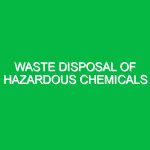In the realm of health, safety, and environment (HSE), recognizing chemical hazards is paramount. Chemical hazards are substances that pose potential risks to health, safety, and the environment due to their physical, chemical, or toxic properties. With industries increasingly relying on chemicals for various applications, understanding and identifying these hazards is critical in preventing accidents and ensuring workplace safety. This article delves into the intricacies of recognizing chemical hazards, exploring their risks, safety precautions, and the regulatory framework that governs them.
The Importance of Recognizing Chemical Hazards
Recognizing chemical hazards is not merely a procedural formality—it’s an essential practice that can save lives and protect the environment. Every year, thousands of workers face health risks and injuries due to improper handling of hazardous substances. For instance, a study published by the National Institute for Occupational Safety and Health (NIOSH) indicated that chemical exposure is linked to numerous occupational diseases, including respiratory disorders, skin conditions, and even cancers.
In my experience as an HSE officer in the manufacturing sector, I witnessed firsthand the consequences of neglecting chemical hazard recognition. A colleague once suffered severe chemical burns while handling an unmarked container. This incident underscored the necessity of rigorous hazard recognition protocols. By fostering a culture of awareness and responsibility, organizations can mitigate risks and enhance employee safety.
Types of Chemical Hazards
When discussing recognizing chemical hazards, it’s crucial to identify the various types that may exist within an environment. Chemical hazards can generally be categorized into several types, including:
1. Toxic Chemicals
Toxic chemicals are substances that can cause adverse health effects upon exposure. These include carcinogens, mutagens, and reproductive toxins. A notable example is benzene, a common industrial solvent linked to leukemia. Continuous exposure to toxic chemicals can lead to long-term health issues, making their recognition imperative.
2. Flammable Chemicals
Flammable chemicals can ignite easily and pose significant fire and explosion hazards. Examples include solvents like acetone and gasoline. A fire incident at a chemical plant I once visited highlighted the critical importance of proper labeling and storage of flammable substances. The absence of clear hazard signs almost led to a catastrophic explosion.
3. Corrosive Chemicals
Corrosive chemicals, such as sulfuric acid and sodium hydroxide, can damage living tissue and corrode materials. Recognizing corrosive hazards is vital in environments where these substances are used, as they can lead to severe injuries or equipment damage if not handled correctly.
4. Reactive Chemicals
Reactive chemicals can undergo violent chemical reactions when they come into contact with certain substances. For instance, mixing bleach and ammonia produces toxic chloramine vapors. This type of hazard requires strict adherence to safety protocols to prevent dangerous reactions.
5. Environmental Hazards
Some chemical hazards have broader implications for the environment. Chemicals that can contaminate soil, water, and air pose significant ecological risks. Pesticides and heavy metals like lead are prime examples of environmental hazards that require careful management and recognition.
Identifying Chemical Hazards
Recognizing chemical hazards involves a systematic approach to identifying potential risks in the workplace. Here are key steps to effectively identify chemical hazards:
1. Material Safety Data Sheets (MSDS)
Every chemical substance should have an accompanying Material Safety Data Sheet (MSDS), which provides crucial information regarding its properties, hazards, and safety precautions. Familiarizing yourself with these sheets is essential. They serve as a primary resource for recognizing hazards associated with specific chemicals.
2. Conduct Regular Audits
Performing regular safety audits of the workplace can help identify potential chemical hazards. During these audits, assess chemical storage, usage, and disposal practices. Engaging employees in these audits can also foster a sense of accountability and enhance hazard recognition.
3. Training and Education
Providing proper training for employees on recognizing chemical hazards is vital. Training should cover topics such as hazard identification, safe handling practices, and emergency procedures. For instance, I recall leading a training session on the dangers of working with isocyanates, which significantly boosted awareness and compliance among the staff.
4. Use of Technology
Advancements in technology can aid in recognizing chemical hazards. For example, employing sensors that detect the presence of hazardous gases can provide real-time data, allowing for swift action in case of an emergency. Such innovations can significantly enhance safety protocols.
Safety Precautions and Best Practices
Once chemical hazards have been identified, implementing safety precautions is essential to mitigate risks. Here are some best practices to consider:
1. Proper Labeling
Every container holding hazardous materials should be clearly labeled. Labels should include the substance’s name, hazards, and necessary precautions. This practice helps in immediate recognition of the dangers associated with the chemical.
2. Personal Protective Equipment (PPE)
Providing appropriate personal protective equipment (PPE) is crucial. Depending on the chemical hazards present, this may include gloves, goggles, respirators, and protective clothing. Ensuring that employees understand the importance of PPE can drastically reduce exposure risks.
3. Emergency Preparedness
Having an emergency response plan in place is vital. This plan should outline procedures for dealing with chemical spills or exposures, including evacuation routes and first-aid measures. Conducting regular drills can ensure that employees are familiar with these procedures.
4. Safe Storage Practices
Following safe storage practices is essential for hazardous chemicals. This includes using compatible storage containers, securing them in well-ventilated areas, and keeping them away from incompatible substances. In my previous role, we implemented a color-coded storage system to help employees quickly identify hazardous materials, which significantly improved safety compliance.
Regulatory Framework for Recognizing Chemical Hazards
Several regulations govern the recognition and management of chemical hazards. Understanding these legal frameworks is essential for compliance and safety:
1. Occupational Safety and Health Administration (OSHA)
OSHA has established regulations concerning hazardous chemicals in the workplace. The Hazard Communication Standard (HCS) mandates that employers inform employees about chemical hazards through proper labeling, MSDS, and training.
2. Environmental Protection Agency (EPA)
The EPA regulates the use and disposal of hazardous substances to protect human health and the environment. Compliance with the Resource Conservation and Recovery Act (RCRA) ensures that companies handle hazardous waste properly.
3. Globally Harmonized System (GHS)
The GHS, developed by the United Nations, provides a standardized approach to classifying and labeling chemicals. Implementing GHS guidelines helps ensure that chemical hazards are recognized universally, promoting safer handling practices worldwide.
Conclusion
Recognizing chemical hazards is a critical component of health, safety, and environmental management. By understanding the various types of chemical hazards, implementing best practices, and adhering to regulatory requirements, organizations can significantly reduce risks to employees and the environment. As industries continue to evolve, so too must our approaches to hazard recognition. By fostering a culture of safety and vigilance, we can create safer workplaces for everyone. Remember, awareness is the first step towards prevention.


